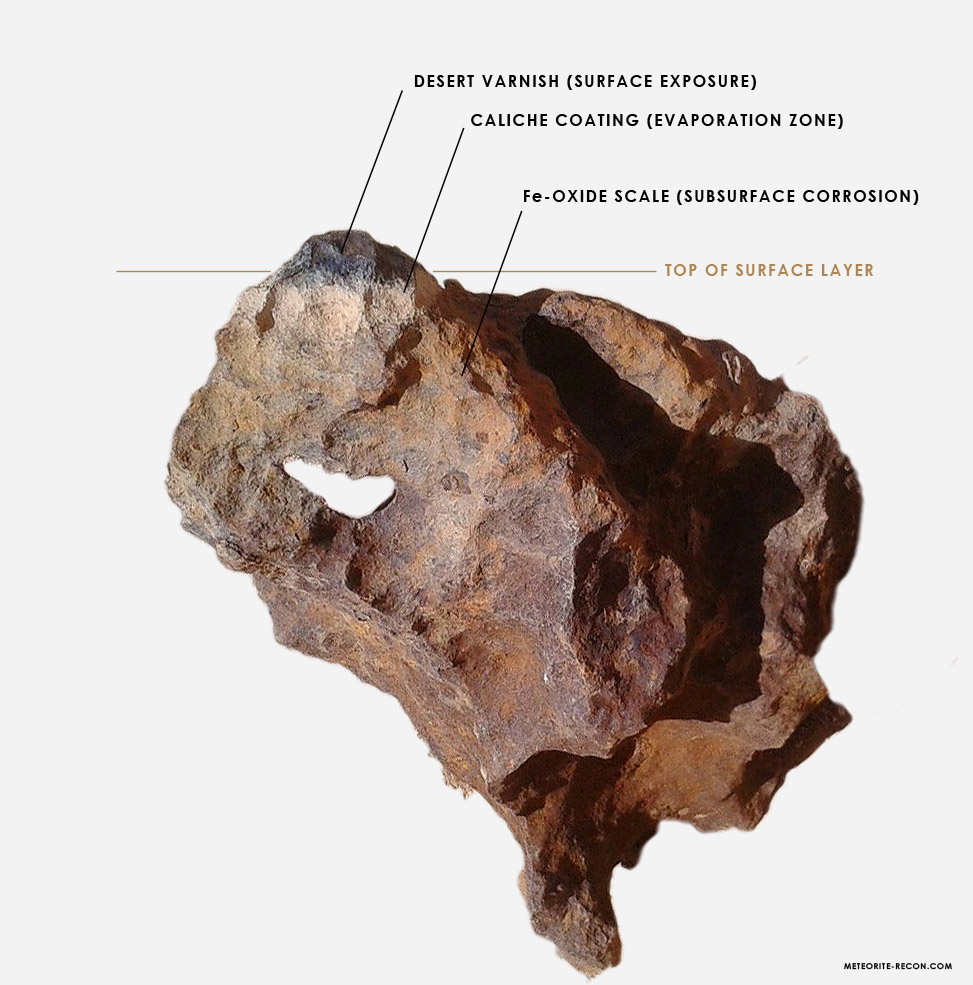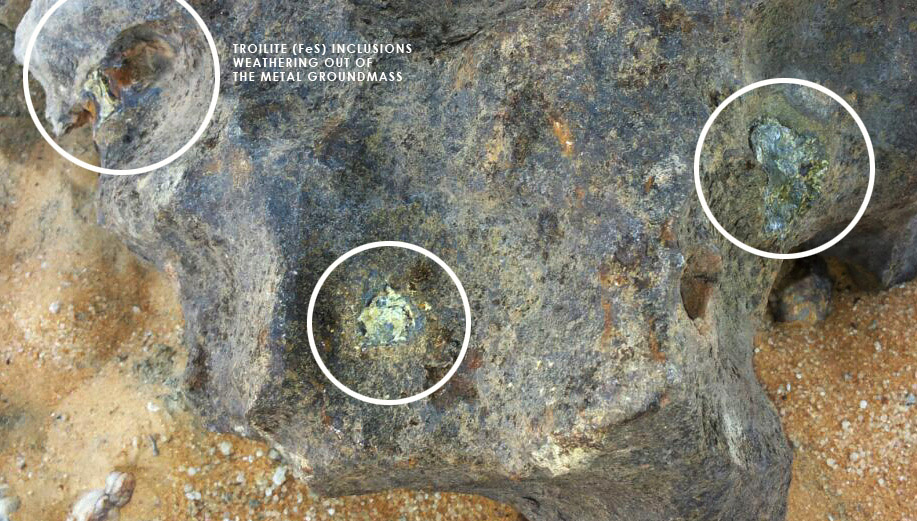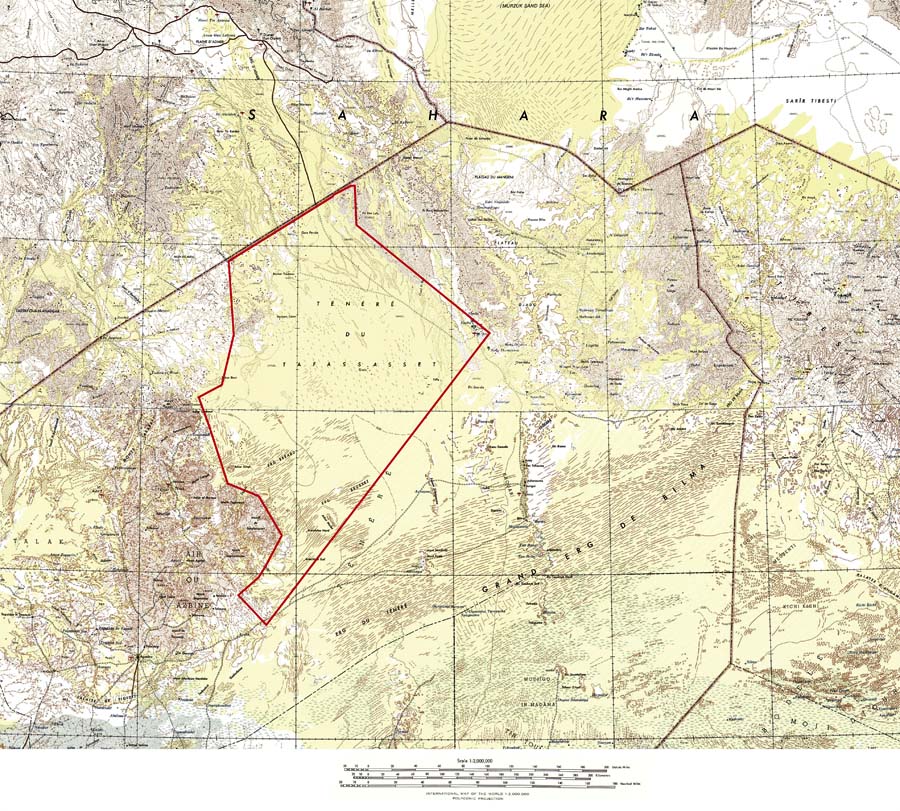The Northeast-Niger Iron Meteorites
Part 3, Analog comparison and general discussion
Reconstructed in situ position for NEN 004 based on the meteorite’s surface texture and terrestrial weathering coatings. Click to supersize
Detail showing weathered troilite on the surface of NEN 001
Map showing the gold prospection and mining area in the Ténéré Tafassasset. As the Niger-Algerian border is neither marked nor monitored, it must be assumed that prospection and mining activities continue cross-border into the north and onto Algerian territory. Map: Sabah, Africa, G8200, U51, Sheet 8, US Army Map Service, Corps of Engineers, Washington D.C. 1969 (Texas University Library, public domain). Click to supersize
Shaping through atmospheric entry
Smooth-shaped hollows that represent regmaglypts or slightly modified regmaglypts indicate that the overall shapes of NEN 002, 003 and 004 (a) may not differ significantly from their original post-fall outlines. In the case of 002, this is supported by the presence of a trapped melt pool in a partially excavated FeS inclusion and which is resulting from ablation during atmospheric entry (Buchwald 1975).
Other instances of cavity enlargement may be regmaglypt controlled in their spacing, but may also be caused by the removal of troilite nodules, which can excavate completely during atmospheric entry. Borehole-like excavations of smaller scale on NEN 001, 002, 003 and 4 (a, b) can be attributed to the melting of the less resistant troilite from the surrounding metal groundmass trough entry holes that were opened during the atmospheric ablation process (Ashley 2011).
Surface weathering
Narrow flutings, scallops and regmaglypt modifications with locally oriented unidirectional symmetry indicate physical ablation by windblown sand grains (Laity 2009) and are only observed on NEN 002. Desert varnish indicating portions of the meteorite exposed above the soil horizon has formed on NEN 002 on one ~15 cm long protrusion of NEN 004 (a) and on fragments 004 (b) and (c). Thus, NEN 004 (a, b c) display a combination of surface and subsurface weathering effects (Al Kathiri 2006).
Subsurface weathering
In combination with troilite weathering out of the metal groundmass, NEN 001, 003 and 004 show a variation of deep pits ranging in size from 3 to ~10 cm in diameter. Some appear to have been enlarged, undercut, or otherwise modified by acidic corrosion on 001, 003 and 004. Widened hollows, breaching vugs and partially excavated troilite nodules indicating corrosive interaction can be found on NEN 001, 003 and 004 (a). Adhering scale of Fe-(hydr)oxoxides and spalling of shale layers are to be seen on all NEN masses with the exception of 002, which shows a limonitic crust coated by a layer of desert varnish and which is a surface find. Exposed crystal planes revealing octahedral Widmannstätten pattern (NEN 003) as well as larger fragments that have detached along cubic planes (NEN 004 a) are suggestive of prolonged corrosive interaction in an acidic environment.
Accumulation surface and Ages
Among the 40 meteorites known for Niger as of February 2016, only Assamakka (IVA-an) is an iron (Ruzicka 2014). Kamacite bandwidths of 0.2-0.4 mm exclude pairing with NEN 002 and 003. Although terrestrial weathering effects on individual irons recovered from a common find area can differ considerably, fresh surface texture with flow features on the 4.4 kg Assamakka iron, as well as its find location west of the Air Mountains support an origin separate of the NEN group. Within 500 km, no other iron meteorites are reported.
Bland (1989), gave a relatively recent age for the Saharan meteorite accumulation surface and identified a rapid initial weathering phase with the majority of the weathering taking place in the first few hundred years after fall. This initial phase is followed by passivation of weathering by porosity reduction. Porosity reduction, and the associated restriction in the ability of water to penetrate the sample, appears to be the mechanism whereby a weathering assemblage formed during the brief initial period of oxidation is preserved through subsequent climatic cycles over the terrestrial lifetime of the sample (Bland 1989). While lower terrestrial ages are considered for the majority of stony meteorites recovered from the Sahara, Chang (1969, Aylmer 1988) has showed that some meteorites could apparently survive for very long times on the surface of Earth (Jull 2006) and determined very high terrestrial ages for some of the iron meteorites found in arid environments (e.g. 2.7 Ma for Tamarugal, Chile and 2.4 Ma for Arispe, Mexico). With 36Cl data pending for NEN 002, no estimate on the terrestrial ages for the NEN group can provided at present. Given the hyper aridity of the region since at least 7.4 ka BP, and considering the weathering effects described, it is safe to assume that terrestrial lifespans for the NEN iron meteorites must be measured in scales of 103 to 104 years at least.
Summary
Based on structural, morphological and geographical evidence, we suggest the hypothesis that the NEN 001 – 003 iron meteorites represent fragments of a single meteorite fall event with a common origin from recently worked gold fields in the area between Adrar Bous, Mt. Ibl, Djado and Orida in the Ténéré Tafassasset, Northeast Niger. Concerning NEN 004 (a, b, c, d) the little evidence that is available remains inconclusive. To prove or falsify the pairing hypothesis, an effort has been made to acquire sample material of one of the subsurface finds, in order to compare chemical and structural composition with the present sample of NEN 002. We also conclude that the current size and shape of the meteorites is approximate to their original postfall contours. Their morphology thus likely results from a combination of atmospheric interaction and postfall weathering effects, with NEN 001 and 003 representing subsurface finds, NEN 002 being a surface find, and NEN 004 (incl. c and d) representing partially embedded finds.
Sources
Al Kathiri, A.. Hofmann B.A., Gnos, E. et al (2006): Shisr 043 (IIIAB medium octahedrite): The first iron meteorite from the Oman desert. In: Meteoritics & Planetary Science 41, Nr. 8, Supplement A217-A320
Ashley, J. W.; Golombek M. P.; Schröder, C. et al. (2010): Morphologic evidence for mechanical and chemical weathering of three new iron nickel meteorites on Mars – Insights for Meridiani Planum. In: 41st Lunar and Planetary Science Conference, 2208
Ashley, J. W.; Golombek M. P.; Christensen, P.R., et al. (2011): Evidence for mechanical and chemical alteration of iron-nickel meteorites on Mars: Process insights for Meridiani Planum, Volume 116, J. Geophys. Res., Vol. 117, Issue E7, pp. 2156-2202
Ashley, J. W.; Golombek M. P. (2016): Analog studies of iron meteorites found on Mars – Features, Processes, and comparisons. In: 47th Lunar and Planetary Science Conference, 2461
Aylmer D., Bonnano V., Herzog G. F, et al. (1988): 26Al and 10Be production in iron meteorites. Earth Planet. Sci. Lett., 88, 107–118
Baumhauer, R.; Busche D.; Sponholz B. (1989): Reliefgeschichte und Paläoklima des saharischen Ost-Niger. In: Geographische Rundschau, 41 (9), p. 493
Baumhauer, R. (2004): Die spätpleistozänen und holozänen Paläoseen in der zentralen Sahara – neue Ergebnisse aus der Ténéré, dem Erg de Ténéré und dem Erg de Fachi-Bilma, NE-Niger. In: Beitrag zur Regionalen Geographie, Die Erde 135 (3-4), p. 291
Baumhauer, R.; Felix-Henningsen, P.; Schütt, B. (2009): Geomorphological and palaeoenvironmental research in the South-Central Sahara in review. In: Holocene Palaeoenvironmental History of the Central Sahara: Palaeoecology of Africa Vol. 29, An International Yearbook of Landscape Evolution and Palaeoenvironments, Baumhauer, R and Junge, J, (Ed.) p.1
Bland, P. A. ; Sexton, A. S. ; Jull, A. J. T. ; et al. (1998): Climate and rock weathering: A study of terrestrial age dated ordinary chondritic meteorites from hot desert regions, Geochim. Cosmochim. Acta, 62, 3169–3184
Buchwald, V. F. (1975): Handbook of Iron Meteorites. Univ. of Calif. Press, Berkeley, 3 volumes, pp. 1418
Busche, D. (2010): North-Eastern Niger: Sandstone Landscape of the Sahara. In: Geomorphological Landscapes of the World. Ed. Piotr Migon, p. 171
Chang C.; Wänke H. (1969): Beryllium-10 in iron meteorites: Their cosmic-ray exposure and terrestrial ages. In: Meteorite Research (P. Millman, ed.), pp. 397–406
Dorn, R.I.; Oberlander, T.M. (1981): Microbial origin of desert varnish. Science 213: 1245-1247
Fioriti, J. (2015): Frenzied Gold Rush sweeps north Niger. In: Mail&Guardian Africa, 29 June 2015, retrieved from http://mgafrica.com/article/2015-06-29-frenzied-gold-rush-sweeps-north-niger-but-the-most-precious-commodity-iswater
Frost, M.T. (1965): Kamacite plate width estimation in octahedrites. In: Mineralog. Mag. 35, pp. 640-642
Hampel, W. (2001): Proposal for a US $ 200,000 Exploration Programme on the Tafassasset Exploration Licence, Aïr Mountains, Niger, Baldham, p.1.
HANEA, Presidence de la Republique Haute Autorite Nigerienne A L’Energie Atomique (2015): Autorisation d’Exportation des Echantillons de Roche. Niamey, Niger, 014/2015, 1p.
Jull, T.A.J. (2006): Terrestrial ages of meteorites. In: Meteorites and the Early Solar System II, McSween Harry Y (Ed.), pp. 889-905
Laity, J. E.; Bridges, N.T. (2009): Ventifacts on Earth and Mars: Analytical, field, and laboratory studies supporting sand abrasion and windward feature development, Geomorphology, 105 (3–4), pp. 202–217
Lorenz, R.D.; Zimbelman, J.R. (2014): Dune Worlds. How windblown sand shapes planetary landscapes. pp. 303
Moawad B.; Abdel Aziz A.O.; Mamtimin B. (2014): Flash floods in the Sahara: a case study for the 28
January 2013 flood in Qena, Egypt. In: Geomatics, Natural Hazards and Risk, 7:1, pp. 215-236
Mobbs, P. M. (2000): The Mineral Industry of Niger. In: US Geological Survey Yearbook, . S. Government Printing Office, Denver, Colorado, pp. 37.1-37.2
Muñoz, C.; Guerra, N, J.; Martinez-Frias, R.; et al. (2007): The Atacama Desert: A preferential arid region for the recovery of meteorites – Find location features and strewnfield distribution patterns, J. Arid Environ., 71(2), pp. 188–200
Office National d’Edition et de Presse (ONEP) (2014): Agadez/Découverte d’un site aurifère: Ruée vers l’or au Djado. Abdoulaye Harouna (Ed.), Agadez 2014 (a)
Office National d’Edition et de Presse (ONEP) (2014): Agadez : Découverte d’un nouveau site aurifère dans le massif de Ibl. Abdoulaye Harouna (Ed.), Agadez 2014 (b) [conflicting location data in the text]
Pachur, H.J.; Altmann, N. (2007): Die Ostsahara im Spätquartär: Ökosystemwandel im größten hyperariden Raum der Erde. p.27
Perry, R.S.; Lynne, B.Y.; Sephton, M.A., et al. (2006): Baking black opal in the desert sun: the importance of silica in desert varnish: Geology, v. 34, pp. 537-540
Reid, I. (2009): River landforms and sediments: Evidence of climatic change. In: Geomorphology of desert environments, 2nd ed., A.J. Parsons and A.D. Abrahams, pp. 695 – 725
Resources Robex Inc. (1999): GeoAfrica Gold Corporation (Press release): Positive Results – Phase 1- Tafassasset Project – Niger, Sainte-Foy, Quebec, 29 June 1999, p. 1
Ruzicka, A.; Grossman, J.N.; Garvie, L. (2014): The Meteoritical Bulletin, No. 100, pp. 101
Thiagarajan , N.; Lee, C.A. (2004): Trace-element evidence for the origin of desert varnish by direct aqueous atmospheric deposition. In: Earth and Planetary Science Letters, 224 (1-2): 131-141
Trendfield Energy & Resources (2007): Trendfield Gold Mining Obtains Gold Permits for Tin Kéradet I, II, III, IV. Press release, Niamey, Niger (PRWEB) April 12, 2007
Trendfield Energy & Resources (2016): Projects, Niger. Company website retrieved 22 January 2016: http://trendfieldonline.com/projects.html
HUMINT Sources
Source A: E.A., Agadez, Niger: Personal communication w. Buhl S. in January 2015 and February 2016.
Source B: S.I, Agadez, Niger: Personal communication w. Buhl S., November-December 2015 and January-February 2016. On behalf of the author, S. I. undertook a four-week survey of the area, gathering data and information from local miners at the gold mining sites and government representatives of the Republic of Niger in Niamey. S.I. is missing in the Tafassasset since mid-February 2016
Source C: M.F., Agadir, Morocco. Meteorite dealer. Personal communication w. Buhl S. in February 2015. M.F. tried to market NEN 003 and 004 on behalf of the anonymous owners via middlemen based in Tindouf, Algeria.
Source D: C.T.: Noukchott, Mauritania. Personal communication w. Buhl S., January – February 2016. C.T. dispatched a correspondent from Bordj Badji Mokhtar on behalf of the author to Kidal Province, Mali, to investigate an alleged find location of NEN 004. C.T. also interviewed middlemen in Tindouf, Algeria, with the goal to establish contact with the actual finders of the NEN meteorites.





